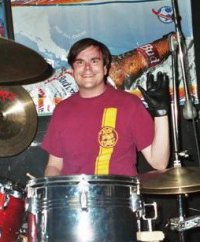While the So Cal punk scene has inspired enough publications to fill a shelf, it’s rare that I’ve heard about any serious attempts to recollect what was going on in my neck of the woods, New Jersey, back in the middle 80s. So it’s very satisfying personally to see the long-awaited publication of this book by Amy Yates Wuelfing and Steven DiLudovico that focuses its vision on my old hometown club, the titular City Gardens of Trenton, and gives the main characters – musicians, club employees and audience – a chance to tell their own oral history.
One key function City Gardens served for us of high school age was providing all-ages shows for bands that normally played in bars. We were lucky enough to have two great college radio stations (Dean Ween was a fanzine author and DJ on WTSR at the age of 15, and thus a high muckety-muck of the scene long before Ween started performing), and thus a pretty well-informed audience of under-21s. I would occasionally meet kids from New York or Philly that had to come to Trenton for gigs, who told me we didn’t know how lucky we were to have the place.
The authors cover events chronologically, and talk to a lot of the hardcore touring stalwarts that most people associate with the venue – Rollins, Watt, MacKaye, all the guys from the NYC HC bands – but also the occasional famous hip hop or college-radio heroes like Kool Moe Dee, Beastie Boys, New Order and Peter Murphy (some represented by tour managers or other cohorts) that would occasionally show up, filling an itinerary date between New York and DC, or between Philly and Boston. Booking agent Randy Now had wide-ranging tastes, and knew he needed to work all the multiple angles of what could be termed “alternative,” in order to survive.
Balancing the attention evenly between these different forces of what fell under the general umbrella of “alternative music” feels true to the City Gardens I remember, even if I seem to be remembering some of the details different from other people. (I’m pretty sure by the time Husker Du came around in May of ’85 it was not billed an an all-ages show as one person asserts, because I remember being REAL BUMMED OUT about having to skip that.) There’s a lot of hardcore in here, like there was in my life – I saw Black Flag, Dead Kennedys, Circle Jerks, DOA, Angry Samoans, 7 Seconds, Suicidal Tendencies and countless others of that breed, but I also saw the Residents with Snakefinger there. I saw the Ben Vaughn Combo as a young garage band just finding its feet. I saw some insane pairings, like Living Colour opening for Swans, GWAR pissing off the skinheads who’d come to see Murphy’s Law, or LA hair-metal poseurs the Double O Zeros (no relation to the real “Wimp”/ “Beat Your Heart Out” Zeros – they became the purple haired Zeros if you remember that) with the Circle Jerks. I saw a hardcore band attempt to rap for the first time there. I saw the Ramones there four times, each one packed with people pogoing from the front of the house to the back bar, where budding young comedian John Stewart was serving them drinks and topical quips. (I have no memory of him being there but, I wasn’t yet drinking age, and usually spent any money I had at the merch booth or at the creepy KFC around the corner.)
The authors also spend time on the local band scene of the era, which included a lot of talented folks who never made it big beyond the region, and a few who did.It’s nice to see some ink spilled on my early rock heroes Andrew Weiss and Sim Cain, who went national in Gone and the Rollins Band after stints in the corrosive instrumental trio Regressive Aid and improvisational noise-bomb Scornflakes. Seeing mind-blowingly original bands like that in local bars was an experience that changed my mind about the possibilities of rock music when I was about 15, and it’s remained an indelible lesson – the most interesting stuff is often happening on the margins, and it’s up to you to seek it out and catch it before the moment is gone.
If it feels like I’m writing my own chapter for this book instead of reviewing the one that exists, it’s because I can’t help it; that was my story too, and it’s surreal to see it written down. It’s not like reading another in-depth exploration of LA hardcore. Someone from LA might not understand why people talk about Adrian Belew and Gene Loves Jezebel in the same breath as Dead Kennedys, because there’s never been a time in LA when there was only one venue that people counted on to bring in every touring act potentially worth seeing. Randy and his crew kept the place hopping, and it’s hard to believe anyone who appreciates the period, whether from up close or afar, wouldn’t enjoy this book.




May the goddess bless Randy Now.
“Residents with Snakefinger”!!!!!!!!